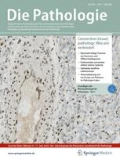Zusammenfassung
Die histologische Bestimmung des Anaplasiegrades von Gliomen wird nach qualitativen histologischen Merkmalen (Kernpleomorphie, Mitosen, Endothelproliferate, Tumornekrosen) vorgenommen und mit dem Malignitätsgrad gleichgesetzt. Vor allem die Wichtung dieser Merkmale (”gering – mittel – stark ausgeprägt”) unterliegt dem subjektiven Eindruck des jeweiligen Befunders. Um eine höhere Reproduzierbarkeit der Gradingbeurteilung zu erreichen, wurde auf die Wichtung verzichtet und lediglich das Vorhandensein oder Fehlen dieser vier definierten qualitativen Kriterien verzeichnet. Es hat sich gezeigt, daß durch dieses binäre System eine verläßlichere Aussage über die Dignität von Gliomen möglich ist (Ste. Anne-Mayo-System, SAMS). Neuere Untersuchungen belegen, daß auch für das Grading der Oligodendrogliome und der Mischgliome ein ähnliches binäres System praktikabel ist, wobei sowohl für die Astrozytome als auch für die Oligodendrogliome die Unterscheidung einer niedrigen und hohen Risikogruppe über das Fehlen oder Vorhandensein von Endothelproliferaten durchgeführt wird. Die Endothelproliferate ihrerseits – als Zeichen einer in Gang gekommenen Tumorangiogenese – korrelieren mit der Kontrastmittelanreicherung bei der kranialen Computer- und Kernspintomographie.
Summary
The histologic determination of the degree of tissue anaplasia and grade of malignancy of gliomas is based upon qualitative histological features (nuclear pleomorphism, mitoses, endothelial proliferation, tumor necrosis). This grading approach is influenced by the subjective interpretation of the pathologist, especially concerning the weighting of criteria (scant, moderate, pronounced). An observer-independent approach seems to be feasible by abandoning the concept of parameter weighting in favor of an binary approach noting only the presence or absence of these structure parameters. This grading procedure is recognized in the revised WHO classification of brain tumors for common type astrocytomas (Ste. Anne-Mayo System, SAMS). Our results indicate that a similiar approach is also suitable for grading purposes of oligodendrogliomas and mixed gliomas. Our recent investigations on glioma grading showed, both for astrocytomas and oligodendrogliomas, that a two-tiered grading scheme distinguishing only ”low-grade” and ”high-grade” cases was prognostically relevant. For all glioma entities the onset of tumor angiogenesis with endothelial proliferation and contrast enhancement in CT and MRI seems to be the key criterion indicating irreversible tumor progression to the ”high” malignancy grade.
Author information
Authors and Affiliations
Rights and permissions
About this article
Cite this article
Kolles, H., Niedermayer, I. & Feiden, W. Grading von Astrozytomen und Oligodendrogliomen. Pathologe 19, 259–268 (1998). https://doi.org/10.1007/s002920050282
Issue Date:
DOI: https://doi.org/10.1007/s002920050282

